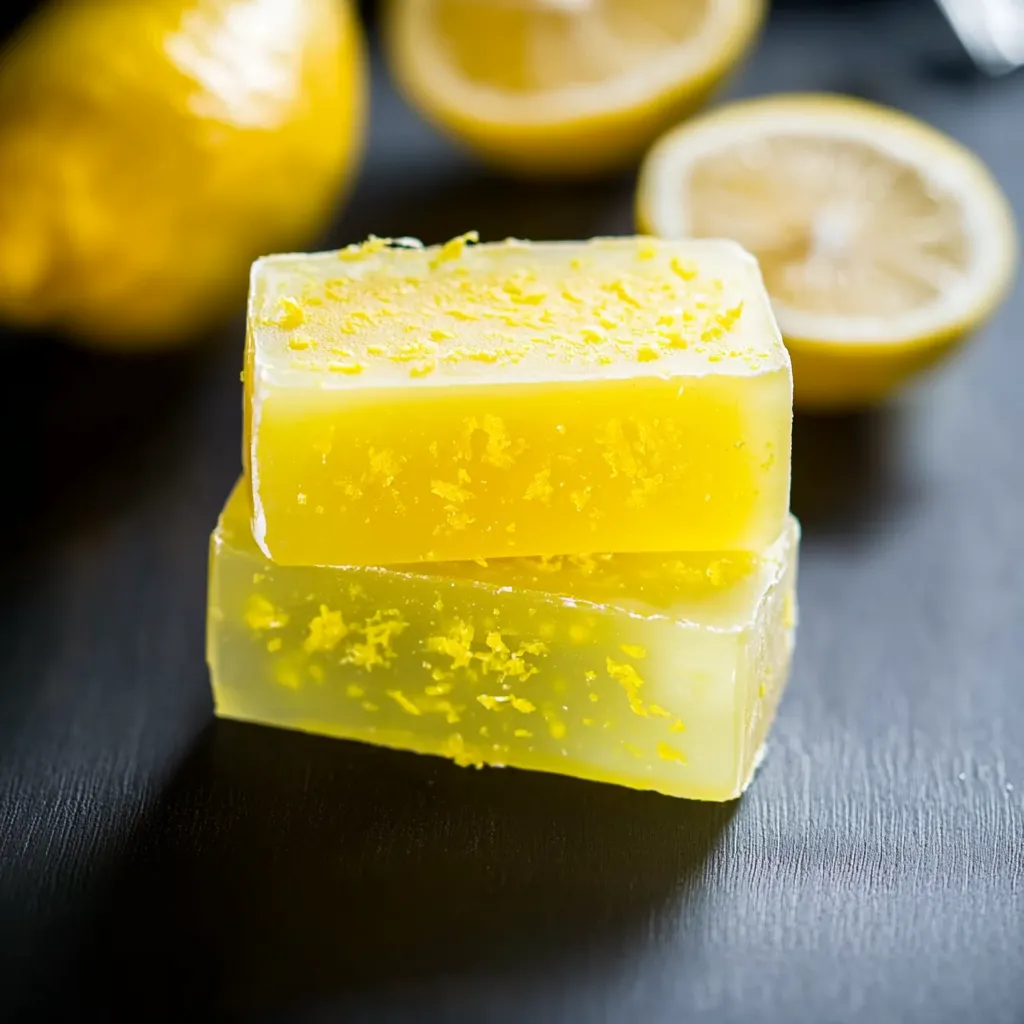 Pin it
Pin it
Handcrafted soap making transforms ordinary bathroom routines into sensory experiences worth savoring. The process of creating lemon zest soap brings together the bright, invigorating scent of fresh citrus with the gentle cleansing properties of glycerin. This particular recipe showcases how simple ingredients combine to produce something both beautiful and functional. The transparent glycerin base allows the natural lemon zest to shine through, creating a visually stunning bar that awakens the senses with every use.
Last month I created these bars for my sister's birthday gathering. Her teenage daughter immediately asked if I could teach her to make them, claiming the scent reminded her of summer afternoons at her grandmother's house where lemon trees lined the garden path. We spent the following weekend making a double batch together, creating memories while crafting something beautiful.
Quality Component Selection
Soap Foundation
- Clear glycerin melt-and-pour base: Provides perfect transparency that showcases the natural ingredients
- High-quality glycerin: Creates gentle cleansing action appropriate for most skin types
- The meltable format: Eliminates complicated chemical processes while ensuring consistent results
Citrus Elements
- Organic unwaxed lemons: Yield the brightest flavor and most vibrant visual appeal
- Fresh zest: Contains natural oils that infuse the soap with authentic fragrance
- Yellow outer rind: Provides natural coloring without artificial dyes or additives
Aroma Enhancement
- Pure lemon essential oil: Intensifies the citrus scent beyond what zest alone provides
- Therapeutic-grade oils: Offer potential skin benefits beyond wonderful fragrance
- The concentration: Determines whether the bar provides subtle freshness or bold citrus impact
 Pin it
Pin it
Following my grandmother's advice, I discovered that allowing lemons to reach room temperature before zesting releases more of their essential oils. While experimenting with this recipe, I observed how zest from the same lemon could produce different color intensities depending on how deeply I removed the yellow portion without including the bitter white pith beneath.
Detailed Creation Process
Base Preparation
Cut the glycerin soap base into small, uniform cubes approximately one inch square using a sharp knife on a clean cutting board. This consistent sizing ensures even melting without scorching. Place measured amount into a microwave-safe glass bowl with sufficient capacity for stirring without spillage. The clear bowl allows visual monitoring throughout the melting process.
Gentle Melting
Heat the prepared soap cubes in microwave using 30-second intervals at medium power. Stir gently between each heating session using a silicone spatula. Continue this careful heating process until glycerin reaches complete liquefaction with no solid pieces remaining. The transformed glycerin should appear completely transparent, resembling clear water when properly melted.
Zest Incorporation
Thoroughly wash and dry a fresh, preferably organic lemon. Using a microplane grater, remove only the yellow outer portion of the peel, avoiding the bitter white pith beneath. Add the collected zest to the melted soap base, stirring gently to distribute evenly throughout the mixture. The natural oils from the zest will begin infusing the base immediately with authentic citrus essence.
Aroma Enhancement
Add 10-15 drops of pure lemon essential oil to the mixture, adjusting amount based on desired scent intensity. Stir thoroughly but gently to minimize air bubble formation while ensuring complete incorporation. The combined fragrance of fresh zest and concentrated essential oil creates layered complexity impossible to achieve with artificial fragrance alone.
Molding Technique
Pour the prepared mixture carefully into clean soap molds, filling to just below the rim to allow for slight expansion. Tap molds gently against the work surface to release any trapped air bubbles that would compromise the soap's appearance. Transfer filled molds to a flat, undisturbed surface for proper setting and crystallization.
Setting Period
Allow the poured soap to set undisturbed for approximately one hour at room temperature. The transformation from liquid to solid state happens gradually, with edges solidifying first. Complete hardening throughout ensures the bars will release cleanly from molds without breakage or deformation.
 Pin it
Pin it
My aunt Sarah always struggled with complicated cold-process soap recipes until I introduced her to this method. She called me the following week describing how relaxing her morning shower had become with these bright, cheerful bars catching the sunlight through her bathroom window.
The therapeutic properties of lemon extend beyond its refreshing scent. Citrus oils have natural astringent qualities that can help balance oily skin types. Additionally, the gentle exfoliating texture provided by the zest particles offers subtle renewal with each use. During winter months when seasonal affective disorder dampened my spirits, keeping these sunny bars in my shower routine provided unexpected emotional uplift through aromatherapy benefits.
Beautiful Presentation Ideas
Gift Packaging Concepts
Transform simple soaps into thoughtful presents by wrapping pairs in natural kraft paper tied with raffia or baker's twine. Small wooden tags attached with handwritten labels add personal connection. Consider bundling with a natural sea sponge or wooden soap dish for complete presentation that elevates the handmade aspect.
Display Suggestions
Clear glass apothecary jars showcase the beautiful transparency and zest distribution when displaying multiple bars. Arrange alongside fresh lemons and sprigs of herbs like rosemary or thyme for farmers market booth styling. Stack alternating with other citrus varieties like orange or grapefruit for colorful bathroom counter collections.
Usage Enhancement
Place bars on wooden soap dishes that allow proper drainage between uses to extend their lifespan. Consider cutting larger bars into smaller guest soaps for powder rooms or visitor bathrooms. Combine with natural loofah or sisal wash cloths to maximize the gentle exfoliation properties while creating beautiful bathroom vignettes.
Creative Adaptations
Citrus Variations
Substitute lime zest and essential oil for a slightly sharper, more tropical variation perfect for summer use. Combine lemon with bergamot for an earl grey tea inspired fragrance that appeals to both men and women. Create layered bars with separate pours of lemon, orange and grapefruit for striking visual effect and complex citrus profile.
Texture Explorations
Incorporate poppy seeds alongside lemon zest for additional gentle exfoliation properties ideal for hands and feet. Add dried calendula petals for subtle floral notes that complement the citrus brightness. Experiment with embedded loofah pieces in portions of the bar to create combination cleansing/exfoliation products.
Form Innovations
Pour mixture into silicone ice cube trays for single-use guest soaps with maximum cuteness factor. Create layered effects by allowing each pour to partially set before adding new layer with slightly different properties. Consider embedding smaller lemon soap pieces within larger clear glycerin bars for suspended animation effect that showcases your craftsmanship.
Preservation Guidelines
Environmental Considerations
Store finished bars in cool, dry location away from direct sunlight which can fade the natural coloring and degrade essential oils. Consider wrapping in beeswax cloths rather than plastic for environmentally conscious protection that allows the soap to breathe properly.
Longevity Techniques
Allow newly unmolded bars to cure for additional 24 hours before packaging to ensure complete hardening throughout. This extra time improves longevity during use and sharpens the finished appearance. Cut larger loaves into individual bars only when ready to use or gift to maintain maximum freshness.
Usage Maximization
Keep bars on well-drained surfaces between uses to prevent premature softening and dissolution. Consider cutting larger bars in half for children or shorter shower routines. Collect small remaining pieces in a mesh bag that can continue providing lather long after individual bars would be considered too small for comfortable handling.
 Pin it
Pin it
My journey into soap making began from curiosity but evolved into genuine passion after experiencing how completely different handmade bars feel compared to commercial alternatives. The most valuable technique I discovered came through trial and error: allowing the melted base to cool slightly before adding essential oils preserves their aromatic qualities far better than adding them at peak temperature. During a workshop with a veteran soap maker, she shared that patience creates quality in this craft. "Rushing any step changes what could be extraordinary into merely acceptable," she told me while demonstrating how gentle stirring prevents the cloudy appearance that comes from incorporating air bubbles. The extra few minutes this careful approach requires translates to crystal clear bars that showcase the beautiful lemon zest suspended throughout each use.
Frequently Asked Questions
- → How long does homemade soap last?
- When stored in a dry place, it can last 6-12 months with proper drainage between uses.
- → Where can I find glycerin soap base?
- Available at craft stores, soap making suppliers, or online retailers.
- → Can I use other citrus fruits?
- Yes, try orange, lime, or grapefruit zest with matching essential oils.
- → Why is my soap cloudy?
- This happens if soap cools too slowly. Work quickly after melting for clearer results.
- → Can I add color to this soap?
- Yes, add soap colorant or a small amount of food coloring for a yellow tint.
